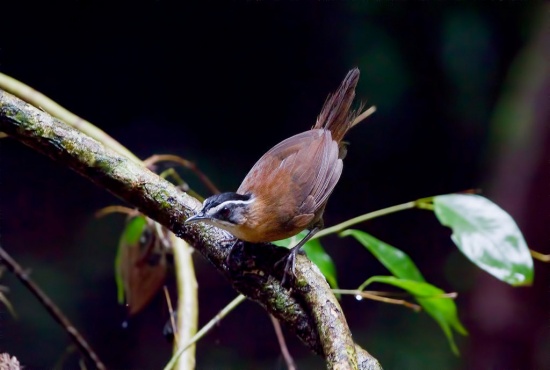- Pellorneum capistratum
Identification
16 - 17cm. A babbler with a striking head pattern.
- Black crown and nape
- Supercilium from above lores to behind eye deep orange-rufous becoming buffy white in nominate. Morelli and capistratoides with white supercilium, grey in nigrocapitatum.
- Lores pale grey, ear-coverts orange-tinged in nominate, blackish in capistratoides and morelli, grey with black moustachial stripe in nigrocapitatum
- White throat
- Chestnut back, wings and tail
- Orange-rufous underparts
- Black bill
- Grey legs and feet
Sexes similar. Juveniles have browner cap and orange-rufous throat
Distribution
Found from extreme south Burma and Thailand to the Malay Peninsula and on Borneo, Sumatra and Java.
Common in parts of its range.
Taxonomy
Subspecies
There are 4 subspecies[1]:
- P. c. nigrocapitatum in extreme south Burma, extreme south Thailand, the Malay Peninsula, Sumatra, Bangka, Belitung and north Natuna Islands.
- P. c. morelli in north Borneo (Sabah) and Banggi Island
- P. c. capistratoides in west, central and south Borneo
- P. c. capistratum on Java, Indonesia
Habitat
Moist lowland forests, dense vegetation. Up to 760 m on mainland Asia, 1300m in Java and 1400m in Borneo.
Behaviour
Usually seen singly or in pairs. Foraging on ground, walking along the leaf litter. Seldom seen more than 0.5m above ground.
Resident species.
Diet
Feeds on insects, spiders, worms and snails.
Breeding
Breeding season from May to June in Borneo, February to April and August to December in Java, April to June on the Malay Peninsula. The nest is an untidy cup made of dead leaves, twigs and coarse fern roots. It's placed on the ground, sheltered by leaves or up to 0.6m above the ground in a spiny palm or a bush. Lays 2 eggs.
References
- Clements, JF. 2011. The Clements Checklist of Birds of the World. 6th ed., with updates to August 2011. Ithaca: Cornell Univ. Press. ISBN 978-0801445019. Spreadsheet available at http://www.birds.cornell.edu/clementschecklist/downloadable-clements-checklist
- Del Hoyo, J, A Elliott, and D Christie, eds. 2007. Handbook of the Birds of the World. Volume 12: Picathartes to Tits and Chickadees. Barcelona: Lynx Edicions. ISBN 978-8496553422
Recommended Citation
- BirdForum Opus contributors. (2024) Black-capped Babbler. In: BirdForum, the forum for wild birds and birding. Retrieved 16 April 2024 from https://www.birdforum.net/opus/Black-capped_Babbler
External Links
GSearch checked for 2020 platform.1




